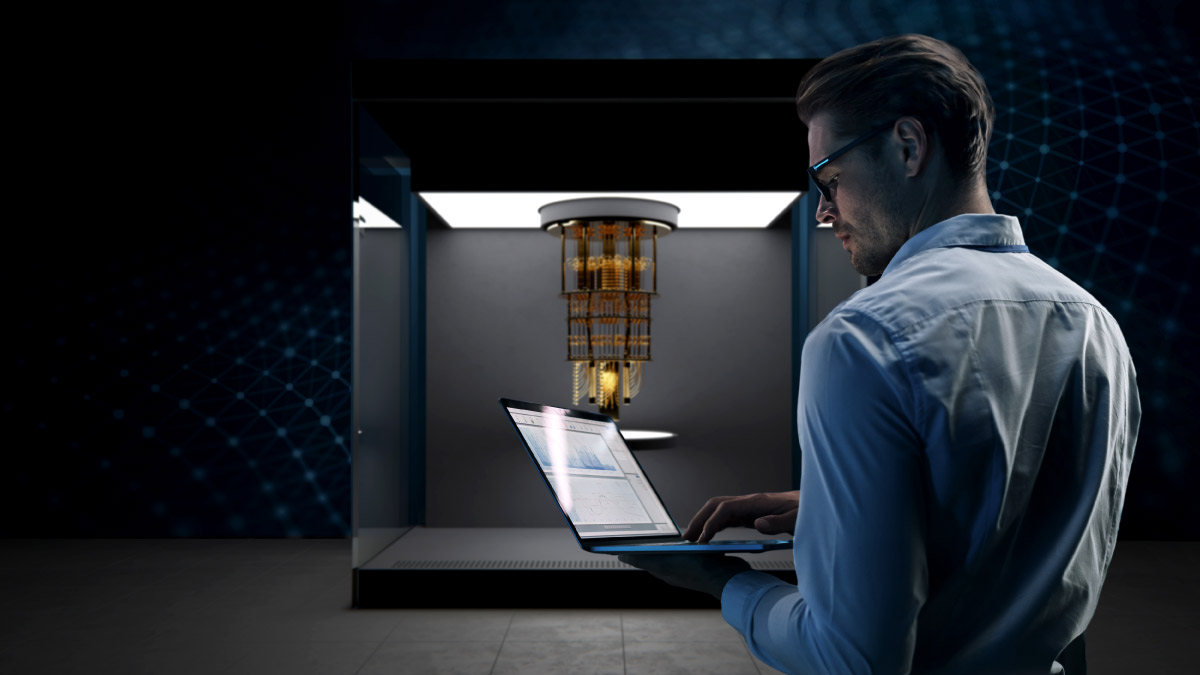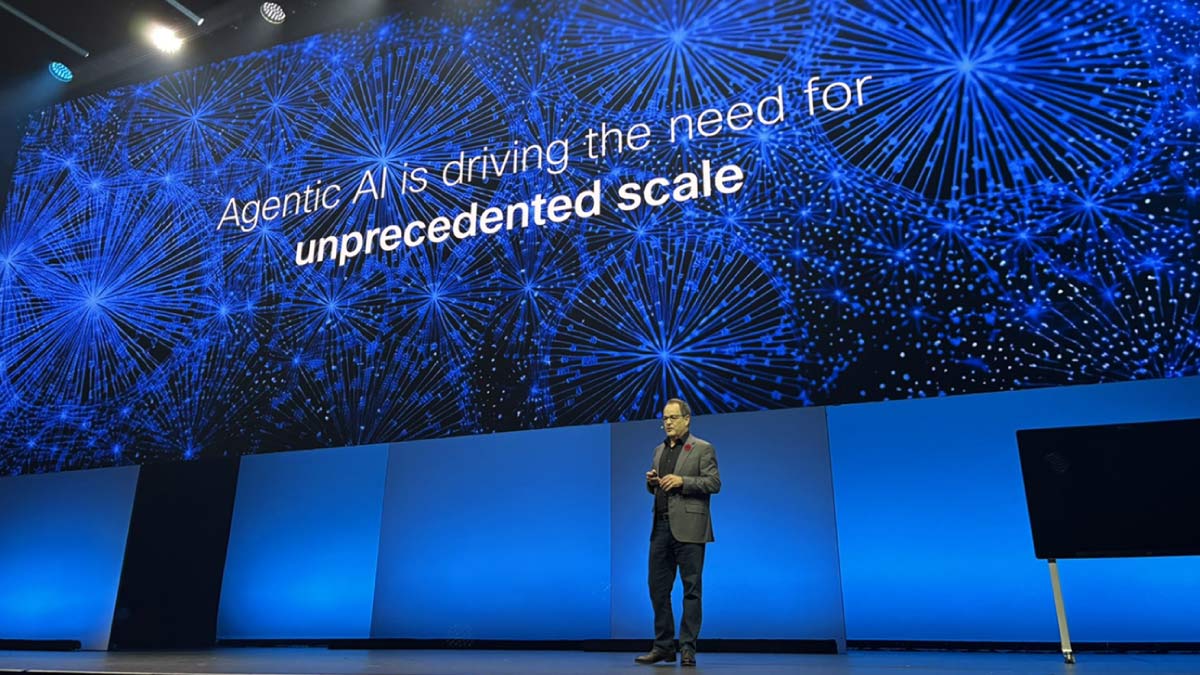As with all things quantum, quantum computing has overturned plenty of long-held assumptions.
How computers function, what they’re capable of, and strategies for securing them must all be rethought. So, smart organizations like Cisco are getting ahead of this coming revolution, which could be even more profound than the one driven by “classical” computing based on binary code (e.g., the device on your desk or in your hand).
“It’s almost like we are going back 70 years and going forward 70 years at the same time,” said Vijoy Pandey, senior vice president of engineering for emerging technologies and incubation at Cisco. “Seventy years ago, we invented the transistor, and we are almost at that kind of starting point of innovation with quantum. But at the same time, we’ve learned so much in 70 years of classical computing, and we can apply those techniques to quantum, to the future.”
Instead of binary digits, or bits, quantum computers employ quantum bits, called qubits. In qubits, ones and zeros are represented by quantum particles like ions or photons. And those quantum ones and zeros are superpositioned. That is, able to exist in different states at the same time. (Yes, you read that right.) By leveraging qubits, quantum computers can crunch vast potential outcomes simultaneously — compared to the classical model, which “only” switches between ones and zeros, one at a time.
More secure and more capable.
No one could have imagined the profound changes driven by the digital age in recent decades. But fasten your seatbelts. Quantum computers — and networks — promise unheard of capabilities. And the implications for everything from medical diagnosis and drug research to astrophysics and artificial intelligence are staggering.
Another staggering implication? Security. A quantum computer could potentially break today’s most advanced cryptography in minutes. But the good news is that quantum defenses, such as quantum cryptography and quantum key distribution (QKD), could counter these threats.
So, the race is on.
“The way to fight quantum is with quantum,” said Pandey. “Quantum computers can be used for novel cyberattacks and could disrupt the way we handle security in all communications. It’s a big problem we are facing as an industry and as a planet, literally. But we are building security systems and paradigms using quantum to protect against that.”
The ultimate payoff could be a network that’s more secure than anything available today.
“Quantum networking could enable a new type of secure connection between digital devices, making them impenetrable to hacks,” Liz Centoni, Cisco’s chief strategy officer and general manager for applications, has stated. “… All of these possibilities would reshape the internet we know and use today.”
Cisco’s expertise in networking, photonics, and, yes, security position it be a key player in this coming revolution.
“We built the foundations of the internet of today,” said Pandey. “Cellular, WiFi, data centers, fiber, these are all very disparate tech that serve different needs. But they all interconnect and form this global Internet. The same thing is going to happen with quantum.”
Where quantum and classical converge, there’s a bridge
To explore the seemingly endless possibilities of quantum, Cisco Research recently established its Quantum Lab in Santa Monica. With partnerships in academia and national labs, it’s helping turn quantum’s promise into real-world use cases and solutions.
“There are still many hurdles to realizing the full potential of quantum,” said Ramana Kompella, Head of Cisco Research. “Given the problematic nature of qubits, harnessing them takes a tremendous engineering feat, but we are getting there.”
Envisioning just what a quantum network or data center would look like is step one. One important part of the equation is that quantum computers will not suddenly replace the classical model. And quantum and classical will need to interoperate seamlessly.
“That’s an area that Cisco plays well in,” said Kompella. “We can connect the networks of the quantum world, and we can be the bridge to classical, because classical is not going away.”
And for the most advanced sensing applications — for example, global climate-change predictions — vast distributed quantum networks will need to communicate.
“Just as we do with classical networks, we’ll need to crunch them together,” added Kompella. “Today, clusters of networks, clusters of servers are interconnected into high-bandwidth networks. Cisco will do the same thing in the quantum realm.”
Moreover, bridging classical and quantum will be critical for turning the power of this emerging technology into scalable business solutions.
“Imagine every network port across the global Internet carrying both quantum and classical payloads together in a provably secure and tamperproof manner,” Pandey said, “so you wouldn’t need to build, deploy, and operate different networks. That’s a future we want to experiment with in our Lab, and eventually enable.”
Particles of light: the photonics advantage
While many quantum efforts focus on superconducting “cages” or trapped ion particles, Cisco is leveraging its expertise in photonics. Photons are weightless particles that carry electromagnetic energy on the light spectrum, and they promise great advantages in sharing and transferring information in a quantum network.
Photonic integrated circuits are already critical components in optical communications and networks. And Cisco recently expanded its prowess in this area with the acquisitions of Acacia and Luxtera — creating what Pandey calls “an unfair advantage.”
Again, the goal is to create scalable quantum solutions using existing technologies and infrastructure wherever possible.
“To get to that quantum network, we took a bold stance,” Kompella said. “We want to be able to leverage the existing fiber and optical infrastructure. Quantum is fraught with challenges, but if we don’t start with that being the goal, we will end up creating a mess of point solutions for quantum. It will not scale or get us to the end goal.”
While more companies are focused on superconducting solutions, Kompella — and Cisco — believe that only photonics will provide the simplicity and scalability needed. By utilizing photonics, the need for many additional technologies is lessened.
“Take a qubit that is in the superconducting realm and needs to be transported over long distances,” Kompella explained. “You need a transducer that transfers the quantity of information from superconducting realm to a photonic one. In our solutions, the intersection is all photonic. If you’re already using photonic-based processes, then you don’t need the transducers.”
Another advantage? Temperature. Unlike superconducting solutions, photonics does not need to be chilled to near absolute zero. That eliminates another layer of cost and complexity.
“We want everything to be functioning at practical temperatures,” Kompella said, “easy to operate and easy to maintain. And without using superconducting cages, which operate at extremely low temperatures.”
Another challenge in the quantum realm is signal degradation, which can result when qubits are transported across long distances. The quantum repeater is a solution being explored and perfected at the Quantum Lab. In a successful quantum network, multiple repeaters would be positioned to compensate for photon loss along the way.
“It’s one of the important challenges that we are helping to solve,” said Kompella.
Quantum vs. quantum: a new security arms race
Again, the threat of a quantum computer hacking into a classical computer or network is real. And mission-critical trade secrets, intellectual property, or personal data could all be compromised.
One of the most vulnerable points could be encrypted transmission keys. Even their advanced cryptography could potentially be broken with the power of quantum. And a secure quantum network’s data could still be hacked as information is transferred to a classical network.
“When quantum nodes come in, all traffic that flows on the internet today could be at risk,” Pandey warned. “Because the keys we are using today are built with algorithms that quantum computers could crack very easily. That's why everybody is worried.”
Quantum key distribution (QKD) is a potential solution that is being explored at the Quantum Lab and beyond.
“Quantum Key Distribution (QKD) is poised to be particularly impactful because it avoids distribution of the keys over an insecure channel,” Liz Centoni wrote in her 2023 predictions. “In 2023, in preparation for a post-quantum world, we will see a macrotrend emerge with adoption of QKD in datacenters, IoT, autonomous systems, and 6G.”
Being quantum based, QKD takes advantage of what is called the no-cloning theorem. It states that cloning or copying information in an arbitrary quantum state is simply impossible. And if anyone tries, it is easily detected.
“Quantum key distribution is a quantum-based mechanism,” said Pandey. “It’s super hard for anybody to tap into that mechanism. But if somebody does, it’s actually provably secure. We can tell if anyone has come in and tried to tamper with the security keys. So, it can be part of a long-term solution on quantum security.”
Security, photonics, and converged classical/quantum networks are three of the key pillars of Cisco’s long-term vision of the quantum future. It’s a future that demands bold innovation, a foundation of established expertise, and strong partnerships, as Kompella concluded.
“We have set some broad but bold research goals,” he said. “And we are defining a long-term vision that will lead to the secure converged quantum/classical internet. We have all the pieces in place. And we’ll work with our partners, the research institutions, to bring them all together in the march towards realizing that longer-term vision.”





